Quirusillas
by
Bennett Hennessey
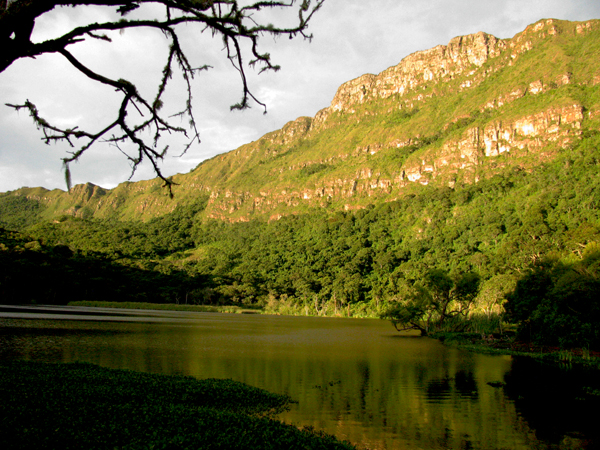 If you are using this free guide, please support Bolivian Bird
conservation by designating
a tax deductible donation to Asociacion Armonía through ABC (click Armonia logo)
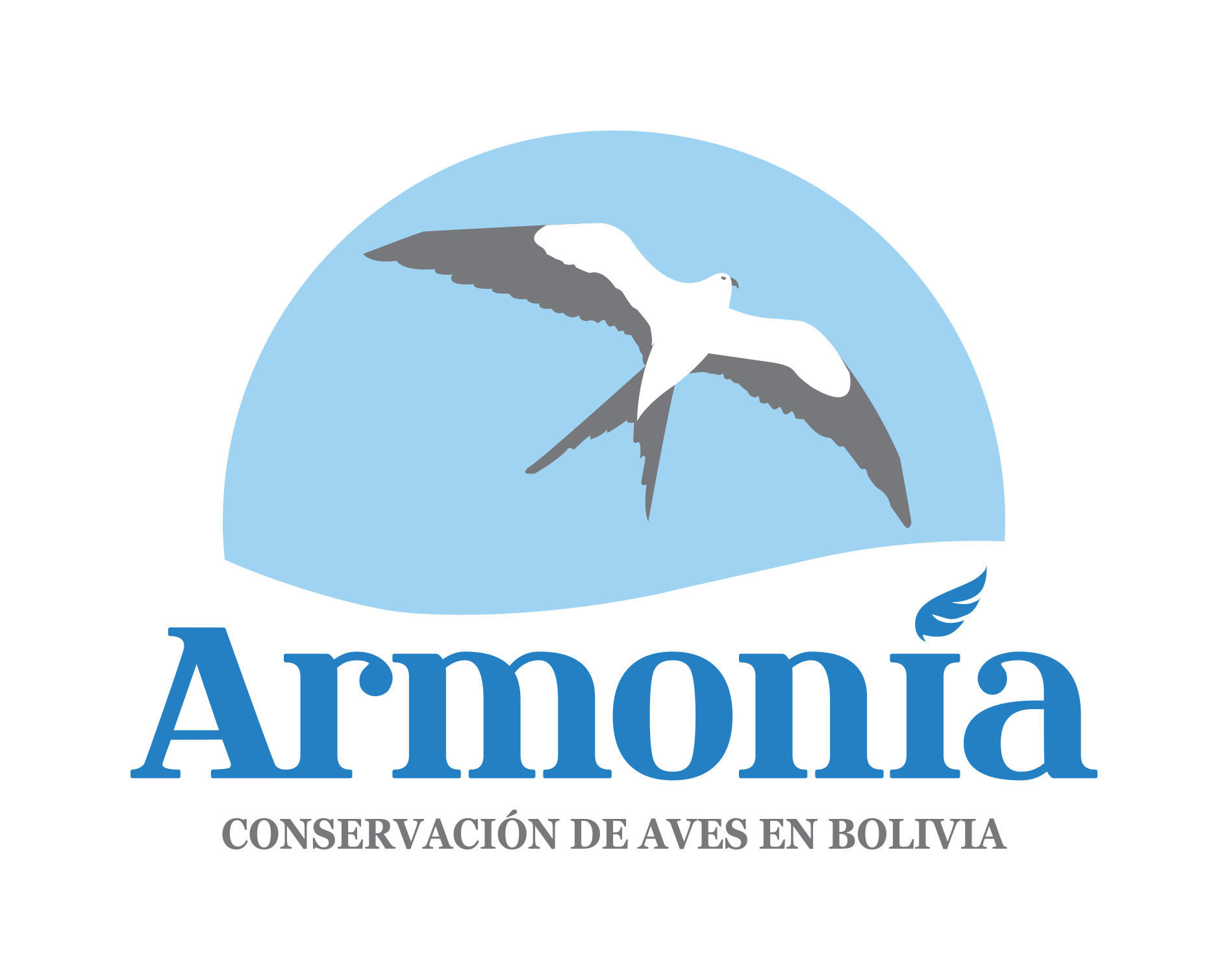
Armonia is working to protect this habitat and the Tucuman Parrot. Please click on the above logos to help support this project.
The key attraction to Quirusillas is that this moist mountain forest, surrounded by dry Andean Valley Habitat, is the furthest northern point for the Tucuman Parrot, hence the most accessible spot from Santa Cruz de la Sierra.
The area is quite remarkable. After a hot dry dusty (as the road is unpaved) drive, hugging the side of hills and valleys, you reach this tall mountain predominated covered in clouds. A humid mountain peak in this dry landscape holding the northern most remnants of Tucuman forest, famous for its “alder”, Podocarpus pine trees and hence the local name of this parrot- Loro Pinero (Alder Parrot).
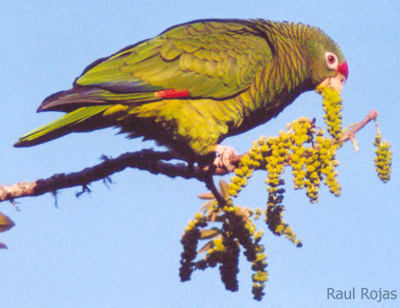 Quirusillas is a great change of pace from everything around. I have visited the site four times, once in a day of mist, twice overcast throughout the day, and once in the sun. The Tucuman Parrot would appear to be rare with seasonal movements through this area- as in July and October they were only heard, but in December we had several observations throughout the day, but notably a group of 30 individuals noisily foraging around the Laguna Esmeralda for over an hour. Quirusillas is a great change of pace from everything around. I have visited the site four times, once in a day of mist, twice overcast throughout the day, and once in the sun. The Tucuman Parrot would appear to be rare with seasonal movements through this area- as in July and October they were only heard, but in December we had several observations throughout the day, but notably a group of 30 individuals noisily foraging around the Laguna Esmeralda for over an hour.
Birding around the area can have around 60 species in a day with a possible resident birds count slightly over 100 species. Condors soar along the cliff edges, while White-throated Antpittas call in the forest. Some of the birds in the area are Golden-winged Cacique, Straw-backed Tanager, Short-tailed Antthrush, Raquet-tailed Puffleg, and White-throated Quail-dove. Forest birding is a mix of Yungas Cloud forest species and dry Andean Valley Species. Another Tucuman forest speciality, the Slaty Eleania has only been seen here in the green season Dec- to April. On my last two trips, my son and I heard guans in the forest around the lake, at least three but we are not sure which species they are.
The habitat can be pleasant as a day out. It is well worth a day’s visit especially as usually the clouds keep the place cool throughout the day. The lake is away from the fields and houses making the area attractive for secluded camping. There is one trail around the man-made reservoir and two simple dirt roads that travelling through healthy Podocarpus forest and edge. Although in theory the entire area is supposed to be protected as a municipal reserve, a lot of the area has been destroyed with farmers’ fields and dug out mini-reservoirs to hold water through the dry season. Quirusillas fits in nicely with a trip visiting Samiapata, Red-fronted Macaw Reserve and Los Volcanes. It is very feasible to leave Samaipata early and visit Quirusillas during the day returning to Samipata. It is also great to camp around the lake.
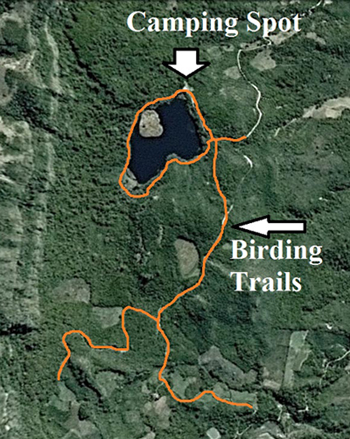 Birding the trail around the lake is fine. The forest is open enough, and with enough cattle allowed to graze the forest, that you can travel up into the forest to find better habitat. Hard to get lost, since up is away and down gets you back to the lake. When you arrive at the lake, the road travels right, to a dead end open area close to the lake (our camping spot). Note on Bolivian long weekends this large cleared are can fill with Bolivians visiting for a days BBQ with amplified sound systems and drinking frolic. But most of the time the entire area is shared with two kids fishing the lake under "no Fishing" signs. You can also bird the road to the left, and take the next road to the right which travels up and through decent habitat. We have found this area better for the Tucuman Parrot. Remember you can go under the barba wire and search the forest with lots of cattle trails- but fairly open. Travelling the road south of the Laguna, there is an area with tall Euculyptus trees in a row. If you make your way to these trees, you will find a secluded spot where a European made his rock humble house with a well (we like to think it was a hiding Nazi living out his last days in fear). This area could be a great hidden camping spot with an beautiful vista surrounded by dry forest and valley moist forest. Birding the trail around the lake is fine. The forest is open enough, and with enough cattle allowed to graze the forest, that you can travel up into the forest to find better habitat. Hard to get lost, since up is away and down gets you back to the lake. When you arrive at the lake, the road travels right, to a dead end open area close to the lake (our camping spot). Note on Bolivian long weekends this large cleared are can fill with Bolivians visiting for a days BBQ with amplified sound systems and drinking frolic. But most of the time the entire area is shared with two kids fishing the lake under "no Fishing" signs. You can also bird the road to the left, and take the next road to the right which travels up and through decent habitat. We have found this area better for the Tucuman Parrot. Remember you can go under the barba wire and search the forest with lots of cattle trails- but fairly open. Travelling the road south of the Laguna, there is an area with tall Euculyptus trees in a row. If you make your way to these trees, you will find a secluded spot where a European made his rock humble house with a well (we like to think it was a hiding Nazi living out his last days in fear). This area could be a great hidden camping spot with an beautiful vista surrounded by dry forest and valley moist forest.
Logistics: From Samiapata travel along the paved road West up the Andes to Cochabamba (not East, down the Andes towards Santa Cruz). The road travels up a peak taking about 15 minutes to reach the top. You will want to pull over on the first town you come to on the left, around 5 km down the road. 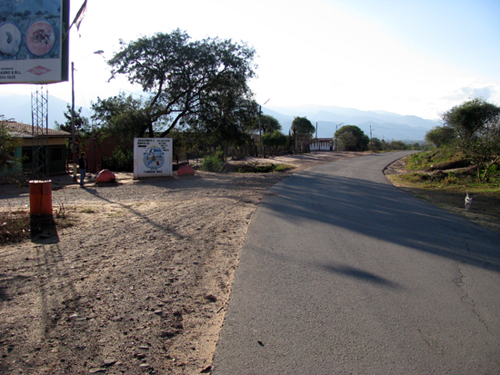 On the left you will see a sign that says “Area Protegida Laguna Esmeralda” (photo). This is a few houses town, before the road passes the next large town (where you can get gas). You need to travel on this dirt road 27 km to the town of Quirusillas. It is the only large dirt road. Follow the road through fields and dry valleys. At around 20km you will see a sign on the right pointing to a small road indicating Laguna Esmeralda 6 km. Follow this smaller dirt road into the town of Quirusillas. You will need to make a right turn to the only road to the Laguna. The road leading out of the town has been paved by rounded rocks. Travel until you see this road directly in town (calle Vallegrande). Turn right and stay on the right to pass a river with a simple tree trunk bridge. On the other side, turn left following the rock paved road up to the top. On the left you will see a sign that says “Area Protegida Laguna Esmeralda” (photo). This is a few houses town, before the road passes the next large town (where you can get gas). You need to travel on this dirt road 27 km to the town of Quirusillas. It is the only large dirt road. Follow the road through fields and dry valleys. At around 20km you will see a sign on the right pointing to a small road indicating Laguna Esmeralda 6 km. Follow this smaller dirt road into the town of Quirusillas. You will need to make a right turn to the only road to the Laguna. The road leading out of the town has been paved by rounded rocks. Travel until you see this road directly in town (calle Vallegrande). Turn right and stay on the right to pass a river with a simple tree trunk bridge. On the other side, turn left following the rock paved road up to the top.
Camp site: 18°21’2.59 S 63°58’25.9 W
|

